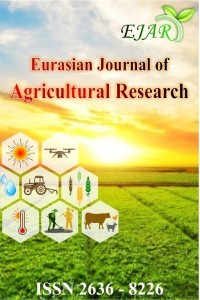Determination of the Amount of Land Area Required for Alternative Second-generation Feedstock to Replace First-generation Feedstock in Biodiesel Production in Turkey
Determination of the Amount of Land Area Required for Alternative Second-generation Feedstock to Replace First-generation Feedstock in Biodiesel Production in Turkey
Plantation area, biofuels, biodiesel, vegetable oil feedstocks sustainability,
___
- Ulukardeşler A.H. & Ulusoy Y. 2012. 3. Nesil Biyoyakıt Teknolojisi olan Alglerin Türkiye de Üretilebilirlik Potansiyeli, Onuncu Ulusal Kimya Mühendisliği Kongresi, 3-6 Eylül 2012, Koç Üniversitesi, İstanbul.
- Göçer S. & Zaimoğlu Z. 2018. Üçüncü ve dördüncü nesil biyoyakıtların araştırılması. Uluslararası GAP Yenilenebilir Enerji Ve Enerji Verimliliği Kongresi, 10-12 Mayıs 2018, pp: 71-75, Şanlıurfa, Türkiye. (Conference paper), GAP Yenilenebilir Enerji ve Enerji Verimliliği Merkezi (GAPYENEV-2018).
- Avcıoğlu A.O., Türker U., Atasoy Z.D.& Koçtürk D. 2011. Tarımsal Kökenli Yenilenebilir Enerjiler-Biyoyakıtlar, Nobel Yayıncılık, Ankara.
- Naik S.N., Goud V.V., Rout P.K. & Dalai A.K. 2010. Production of first and second generation biofuels: A comprehensive review, Renewable and Sustainable Energy Reviews, 14, 578-597.
- IEA, 2010. Sustainable Production of second-generation Biofuels: Potential and perspectives in major economies and developing countries. https://www.iea.org/publications/freepublications/publication/second_generation_biofuels.pdf / (accessed 20 September 2021)
- Navigant Research (2014) Biofuels demand for road transportation will surpass 51 billion gallons annually by 2022. https://www.navigantresearch.com/newsroom/ biofuels-demand-for-road-transportation-will-surpass-51-billion-gallons-annually-by-2022/ (accessed 15 September 2021)
- UNCTAD, 2015. Second generation biofuel markets: State of play, trade and developing country perspectives. United Nations Conference on Trade and Development (UNCTAD). UNCTAD/DITC/TED/2015/8, United Nations Publication.
- Mofijur M., Siddiki Y.A., Shuvho B.A., Djavanroodi F., Rizwanul Fattah I.M., Ong H.C., Chowdhury M.A. & Mahlia, T.M.I. 2021. Effect of nanocatalysts on the transesterification reaction of first, second and third generation biodiesel sources- A mini-review, Chemosphere 270, 128642.
- Gardy J., Rehan M., Hassanpour A., Lai X. & Nizami, A.S. 2019. Advances in nanocatalysts based biodiesel production from non-food feedstocks, J. Environ. Manag. 249, 109316.
- USDA 2020. Statistical data of USDA. Retrieved from: https://usda.library. cornell.edu/concern/publications/ tx31qh68h? locale=en./ (accessed 2 October 2021)
- TÜİK 2019. Statistical data of TUIK. Retrieved from: https://biruni.tuik.gov.tr/ medas/?kn=104&locale=tr./ (accessed 2 October 2021)
- TÜİK 2020. Statistical data of FAO. Retrieved from:https://biruni.tuik.gov.tr/ medas/?kn=92&locale=tr./ (accessed 2 October 2021)
- Irabien A. & Darton R.C. 2016. Energy–water–food nexus in the spanish greenhouse tomato production, Clean Technol. Environ. Policy 18 (5), 1307–1316.
- Hasan A.H. & Avami A. 2018. Water and emissions nexus for biodiesel in Iran. Renew. Sustain. Energy Rev. 93 (5), 354–363.
- Yılmaz A., Yılmaz H., Arslan Y., Çiftçi V. & Baloch F.S. 2021. Ülkemizde Alternatif Yağ Bitkilerinin Durumu, Avrupa Bilim ve Teknoloji Dergisi, Özel Sayı 22, 93-100.
- Gizlenci Ş., Acar M. & Şahin M. 2012. Türkiye’de yenilenebilir enerji kaynaklarının (Biyodizel, biyoetanol ve biyokütle) projeksiyonu, Tarım Makinaları Bilimi Dergisi, 8(3), 337-344.
- Bayramin S. 2006. Aspir (Carthamus tinctoriusL.) / Kolza (Brassica napusspp. oleifera L.) Tarımı ve Islahı, Tarla Bitkileri Merkez Araştırma Enstitüsü Dergisi,15(1-2), 74-85.
- Yıldırım M. 2005. Seçilmiş alternatif keten (Linum usitatissimumL.) hatlarının verimve verim öğeleri bakımından karşılaştırılması. Doktora Tezi, Ankara Üniversitesi Fen Bilimleri Enstitüsü, Ankara. FAO 2014b. Crop Yield. FAOSTAT, http://www.fao.org/faostat/en/#data./ (accessed 25 September 2021).
- Chong C.T., Loe T.Y., Wong K.Y., Ashokkumar V., Lam S.S, Chong W.T., Borrion A., Tian B. & Han N.G.J. 2021. Biodiesel sustainability: The global impact of potential biodiesel production on the energy–water–food (EWF) nexus, Environmental Technology & Innovation, 22, 101408.
- USDA 2017. Foreign Agricultural Service, U.S. Department of Agriculture Gain Report. https://apps.fas.usda.gov/newgainapi/api/report/ (accessed 22 September 2021)
- Johnston M. & Holloway T. 2007. Policy analysis a global comparison of national biodiesel production potentials, Environ. Sci. Technol, 41 (23), 7967–7973.
- Agarwal A.K. 2007. Biofuels (alcohols and biodiesel) applications as fuels for internal combustion engines, Prog. Energy Combust. Sci, 33(3), 233–271.
- Altın R., Cetinkaya S. & Yücesu H. 2001. Potential of using vegetable oil fuels as fuel for diesel engines, Energy Convers. Manage, 42, 529–538.
- Karmakar A., Karmakar S. & Mukherjee S. 2010. Properties of various plants and animals feedstocks for biodiesel productio, Bioresour. Technol, 101(19), 7201-7210.
- ISSN: 2636-8226
- Yayın Aralığı: Yılda 2 Sayı
- Başlangıç: 2017
- Yayıncı: Muhammed Cüneyt BAĞDATLI
Omotayo ADEBOYE, Bart SCHULTZ, Oludolapo ADEKALU, Krishna PRASAD
Determination of Land Use Capabilities by GIS Analysis in Nigde Province, Turkey
M. Cüneyt BAĞDATLI, Mehmet Eren ÖZTEKİN
İlknur BAĞDATLI, M. Cüneyt BAĞDATLI
The Effects of Global Warming on Fish Farming Water Resources
Investigation of the Efficiency of Some Methods Used in the Estimation of Basin Water Yield
Erhan GÖÇMEN, Ahmet İSTANBULLUOĞLU
Evrim ŞİMŞEK, Halil İbrahim OĞUZ, Osman GÖKDOĞAN
A Review on the Integrated Rice-Based Cropping Systems Practices in the Philippines
